The Curious Case of Projected Twenty-First-Century Drying but Greening in the American West
- PMID: 33154610
- PMCID: PMC7641105
- DOI: 10.1175/JCLI-D-17-0213.1
The Curious Case of Projected Twenty-First-Century Drying but Greening in the American West
Abstract
Climate models project significant twenty-first-century declines in water availability over the American West from anthropogenic warming. However, the physical mechanisms underpinning this response are poorly characterized, as are the uncertainties from vegetation's modulation of evaporative losses. To understand the drivers and uncertainties of future hydroclimate in the American West, a 35-member single model ensemble is used to examine the response of summer soil moisture and runoff to anthropogenic forcing. Widespread dry season soil moisture declines occur across the region despite increases in total water-year precipitation and ubiquitous increases in plant water-use efficiency. These modeled soil moisture declines are initially forced by significant snowpack losses that directly diminish summer soil water, even in regions where water-year precipitation increases. When snowpack priming is coupled with a warming- and CO2-induced shift in phenology and increased primary production, widespread increases in leaf area further reduces summer soil moisture and runoff by outpacing decreased stomatal conductance from high CO2. The net effects lead to the cooccurrence of both a "greener" and "drier" future across the western United States. Because simulated vegetation exerts a large influence on predicted changes in water availability in the American West, these findings highlight the importance of reducing the substantial uncertainties in the ecological processes increasingly incorporated into numerical Earth system models.
Figures
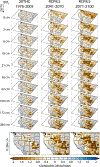

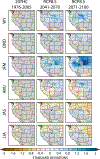
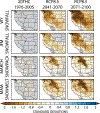
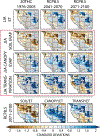



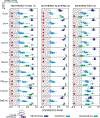


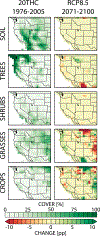


References
-
- Allen R, Pereira L, Raes D, and Smith M, 1998: Crop evapotranspiration—Guidelines for computing crop water requirements. FAO Irrigation and Drainage Paper 56, 300 pp., http://www.fao.org/docrep/X0490E/X0490E00.htm.
-
- Arora VK, and Coauthors, 2013: Carbon-concentration and carbon-climate feedbacks in CMIP5 Earth system models. J. Climate, 26, 5289–5314, doi:10.1175/JCLI-D-12-00494.1. - DOI
-
- Ault TR, Cole JE, Overpeck JT, Pederson GT, and Meko DM, 2014: Assessing the risk of persistent drought using climate model simulations and paleoclimate data. J. Climate, 27, 7529–7549, doi:10.1175/JCLI-D-12-00282.1. - DOI
Grants and funding
LinkOut - more resources
Full Text Sources
